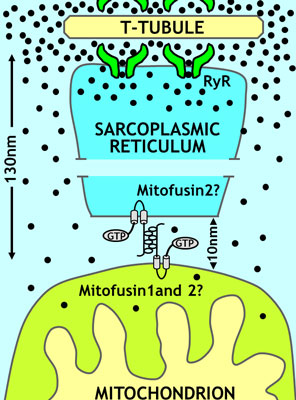 Skeletal muscle contraction is fueled by calcium and ATP. Thus, muscle contractility is intimately linked to the proper homeostatic control of cellular levels of both calcium and ATP. In skeletal muscle, the sarcoplasmic reticulum (SR) is the primary regulator of calcium storage, release, and reuptake, while glycolysis and the mitochondria are responsible for cellular ATP production. However, SR and mitochondrial function are not independent, as calcium uptake into the mitochondria increases ATP production by stimulating oxidative phosphorylation while the production/detoxification of reactive oxygen species (ROS), in turn, modulates SR calcium release and reuptake. Close spatial communication between the SR and mitochondria is facilitated by the structural attachment of mitochondria to the calcium release unit by electron-dense tethers. The resultant anchoring of mitochondria to the CRU provides a structural basis for maintaining bidirectional SR–mitochondrial through-space communication during vigorous contraction. Current work is directed at defining the molecular components that control SR-mitochondrial tethering, mitochondrial calcium uptake and efflux, and calcium-mediated mitochondrial ATP and ROS production.
Skeletal muscle contraction is fueled by calcium and ATP. Thus, muscle contractility is intimately linked to the proper homeostatic control of cellular levels of both calcium and ATP. In skeletal muscle, the sarcoplasmic reticulum (SR) is the primary regulator of calcium storage, release, and reuptake, while glycolysis and the mitochondria are responsible for cellular ATP production. However, SR and mitochondrial function are not independent, as calcium uptake into the mitochondria increases ATP production by stimulating oxidative phosphorylation while the production/detoxification of reactive oxygen species (ROS), in turn, modulates SR calcium release and reuptake. Close spatial communication between the SR and mitochondria is facilitated by the structural attachment of mitochondria to the calcium release unit by electron-dense tethers. The resultant anchoring of mitochondria to the CRU provides a structural basis for maintaining bidirectional SR–mitochondrial through-space communication during vigorous contraction. Current work is directed at defining the molecular components that control SR-mitochondrial tethering, mitochondrial calcium uptake and efflux, and calcium-mediated mitochondrial ATP and ROS production.